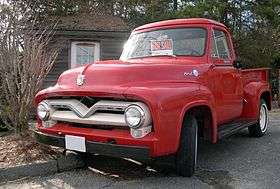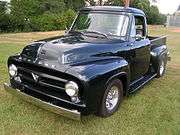Ford F-Series (second generation)
The Ford F-Series was redesigned by Ford for 1953 with a more integrated look. The pickups also obtained their widely familiar names: The F-1 now became the F-100, the F-2 and F-3 now became the F-250, and the F-4 now became the 1-ton F-350. Optional interior amenities were new, including a dome light, lighter, arm rests, sun visors and a radio. On March 13, 1953, the Ford-O-Matic automatic transmission became an option.
| Second generation | |
|---|---|
 | |
| Overview | |
| Manufacturer | Ford |
| Also called | Mercury M-Series |
| Production | 1952–1956[1] 1957–1962 (Brazil) |
| Assembly | Chester, Pennsylvania, USA Dearborn, Michigan, USA Edison, New Jersey, USA Long Beach, California, USA Norfolk, Virginia, USA St. Paul, Minnesota, USA St. Louis, Missouri, USA São Paulo, Brazil (Ford Brazil) Hapeville, Georgia, USA Louisville, Kentucky, USA San Jose, California, USA Highland Park, Michigan, USA |
| Body and chassis | |
| Class | Full-size pickup truck |
| Body style | 2-door pickup 4-door panel truck |
| Layout | Front engine, rear-wheel drive / four-wheel drive |
| Powertrain | |
| Engine | 215 CID (3.5 L) I6 223 CID (3.7 L) Mileage Maker I6 239 CID (3.9 L) Flathead V8 239 CID (3.9 L) Y-block V8 256 CID (4.2 L) Y-block V8 279 CID (4.6 L) Lincoln Y-block V8 317 CID (5.2 L) Lincoln Y-block V8 390 CID (5.9 L) Lincoln Y-block V8 |
| Transmission | Heavy-duty 3-speed manual[2] 3-speed automatic[3] 4-speed manual Ford-O-Matic[3] |
| Dimensions | |
| Wheelbase | 110.0 in (2,794 mm) (F-100) 118.0 in (2,997 mm) (F-250)[3] 130 in (3,302 mm) (F-350) |
| Length | 189.1 in (4,803 mm) (F-100)[3] |
| Chronology | |
| Predecessor | Ford F-Series first generation (1948–1952) |
| Successor | Ford F-Series third generation (1957–1960) |
Engine types
The 1954 F-100 was the last year for the flathead engine in the US. Models in Canada, however, (Mercury M-Series), retained the flathead. 1954-55 saw the introduction of the new 239 CID overhead valve Y-block V8, dubbed "Power King." The six-cylinder engine's displacement was also increased from 215 to 223 CID and power steering was introduced as an option. In the succeeding years the 239 Y-block was replaced with the 256, 272 and 312.
Body styles
The 1956 F-100 is a one-year only body style. The 1956 F-100 is easily identified as it has vertical windshield pillars and a wrap around windshield as opposed to the sloped pillars and angled windshield of the 1953-55. The 1956 model also offered a larger wraparound back window as an option. Starting in 1956, Ford offered the very rare "Low GVWR" versions of each model. Also in 1956, seat belts became an option.[3]
Construction in Brazil
Second generation trucks were built in Brazil from 1957 to 1962 as the F-100, F-350 and F-600.
Models
Engines
| Engine | Years | Power |
|---|---|---|
| 215 cu in (3,520 cm3) Straight-6 | 1953 | 101 hp (75 kW) |
| 239 cu in (3,920 cm3) Flathead V8 | 1953 | 100 hp (75 kW) |
| 223 cu in (3,650 cm3) Mileage Maker I6 | 1954–55 | 115 hp (86 kW) |
| 239 cu in (3,920 cm3) Y-block V8 | 1954–55 | 130 hp (97 kW) |
| 223 cu in (3,650 cm3) Mileage Maker I6 | 1956 | 137 hp (102 kW) |
| 256 cu in (4,200 cm3) Y-block V8 | 1955 | 140 hp (104 kW) |
| 272 cu in (4,460 cm3) Truck 2V Y-block V8 | 1956 | 172 hp (128 kW) |
| 279 cu in (4,570 cm3) Lincoln Y-block V8 | 1954-56 | 152 hp (113 kW) |
| 317 cu in (5,190 cm3) Lincoln Y-block V8 | 1954-56 | 170 hp (127 kW) |
| 368 cu in (6,030 cm3) Lincoln Y-block V8 | 1956 | 300 hp (224 kW) |
Gallery
 1953 Mercury M-100, a Canada-only rebadged F-100
1953 Mercury M-100, a Canada-only rebadged F-100 1953 Ford F-100
1953 Ford F-100- 1955 Ford F-100
.jpg) 1956 Mercury M-100 pickup
1956 Mercury M-100 pickup- 1956 Ford F-100
References
- Bunn, Don. Classic Ford F-Series Pickup Trucks, 1948-1956. ISBN 9781610608800.
- "Directory Index: FMC Trucks-Vans/1955_Trucks_and_Vans/1955_Ford_F-100_Truck_Brochure". Oldcarbrochures.com. Retrieved 2012-03-03.
- Gunnell, John A. (1993). Standard Catalog of American Light-Duty Trucks. krause Publications. ISBN 0-87341-238-9.
